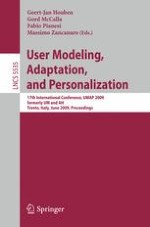This book constitutes the proceedings of the First International Conference on User Modeling, Adaptation, and Personalization, held in Trento, Italy, on June 22-26, 2009. This annual conference was merged from the biennial conference series User Modeling, UM, and the conference on Adaptive Hypermedia and Adaptive Web-Based Systems, AH. The 53 papers presented together with 3 invited talks were carefully reviewed and selected from 125 submissions. The tutorials and workshops were organized in topical sections on constraint-based tutoring systems; new paradigms for adaptive interaction; adaption and personalization for Web 2.0; lifelong user modelling; personalization in mobile and pervasive computing; ubiquitous user modeling; user-centred design and evaluation of adaptive systems.
